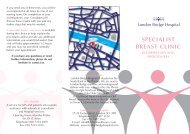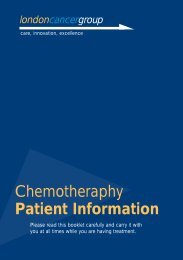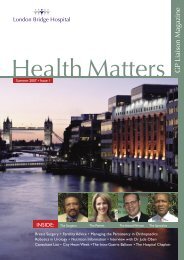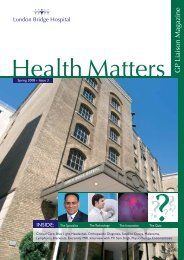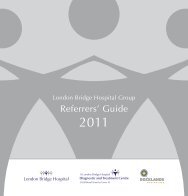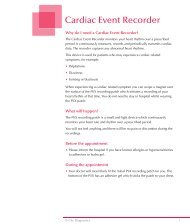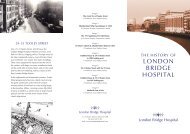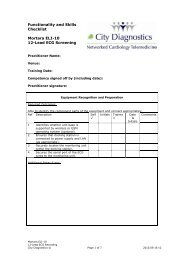Health Matters - London Bridge Hospital
Health Matters - London Bridge Hospital
Health Matters - London Bridge Hospital
- No tags were found...
Create successful ePaper yourself
Turn your PDF publications into a flip-book with our unique Google optimized e-Paper software.
EMG/NCS UseDr Alistair PurvesConsultant ClinicalNeurophysiologistEMG/NCS Usein Primary Careby Dr Alistair PurvesMost GPs will be aware of the existence of departments of ClinicalNeurophysiology in their local hospitals, but historically not many have had directaccess. In my NHS practice at King’s College <strong>Hospital</strong> I have had open access toGPs for some years – currently about 15-25% of my referrals are direct. I findthat the patients coming to us directly are essentially the same as those comingfrom orthopaedics etc, and the rising proportion of GP referrals suggests thatthose who refer are finding it a valuable diagnostic tool.Electromyogram and Nerve Conduction Studies (EMG/NCS) are concernedwith techniques looking directly at peripheral nerve and muscle function viatheir electrical properties. We can characterise nerve damage or compressionproblems, and can indicate the site of this as well as the severity. This is wellestablished for many of the common entrapment neuropathies such as CTS orulnar compression.A new and important area exists in EMG/NCS where patients who present withsymptoms that appear to be neurological like tingling, numbness, pain, clumsinessor weakness in an arm or leg, but where the distribution does not conform toa standard pattern. A typical patient might have pins and needles throughout anarm, weakness or unreliability of grip and poorly localised proximal pain. Spinalimaging often fails to show any abnormality beyond some degenerative changeappropriate to occupation and age.Due to the very neurological flavour of the symptoms there often remainsconcern that there is nerve damage somewhere, and it is very helpful clinicallyto demonstrate that there is no nerve compression or damage either in theperipheral nerves, or in the brachial plexus or in the cervical roots. We oftenfind that patients who have neck and shoulder pain and who have some othercoexisting condition such as carpal tunnel syndrome (CTS), display atypicalsymptoms, e.g. the sensory symptoms are often in the entire hand or even in the‘ulnar’ fingers. We can show the separate components of a mixed picture that canbe clinically very confusing.Dr Purves qualified at Cambridgein 1981, and trained atAddenbrookes <strong>Hospital</strong> andthe National <strong>Hospital</strong> forNeurology and Neurosurgery.He is a Consultant at King’sCollege <strong>Hospital</strong> and providesan extensive service in EMGand conduction studies thereand in Kent. He has a particularinterest in the neurophysiologyof pain syndromes.For more information on EMGand NCS or to contact DrPurves’ secretary, please phone:T: 01622 620910Some patients with what wouldotherwise be called a pure painsyndrome, such as fibromyalgia, doalso have neurological symptoms,and neurophysiology is veryuseful for reassuring patientsand doctors that there is nounderlying nerve damage. If thereis an abnormality, this then allowsan appropriate further referral tobe made – to rheumatology or apain specialist, or to orthopaedicsif there is a peripheral lesion suchas a CTS, or to neurosurgery, ifthere is evidence of cervical orlumbar root lesions.TENEMG/NCS Use



